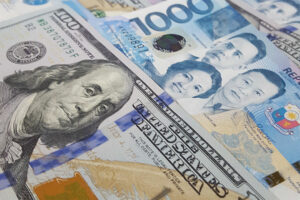THE PHILIPPINE PESO strengthened against the dollar on Monday as investors shifted focus from a widening corruption scandal linked to state flood control projects.
It closed at P58.931 a dollar, up 13.4 centavos from Friday’s P59.065 finish, according to Bankers Association of the Philippines data posted on its website.
The peso opened at P59.055 and traded from P58.91 to P59.199 during the session. Turnover fell to $1.316 billion from $1.837 billion on Friday, reflecting a more cautious market.
“We are seeing sentiment moving on from the recent corruption issues, trending upward toward the close today,” a trader said by telephone.
The rally followed allegations at the weekend by former Party-list Rep. and Appropriations Committee Chairman Elizaldy S. Co that President Ferdinand R. Marcos, Jr. had ordered P100 billion in project insertions in the 2025 budget. The claims were rejected by the Presidential Communications Office and Budget Secretary Amenah F. Pangandaman.
Stronger remittances added support to the peso. Cash remittances rose 3.7% to $3.12 billion in September from a year earlier, Rizal Commercial Banking Corp. Chief Economist Michael L. Ricafort said in a Viber message.
Year-to-date, remittances through banks increased 3.2% to $26.03 billion, bolstering consumer spending and providing a cushion for the currency ahead of the holiday season.
Traders expect the peso to move from P58.90 to P59.20 on Tuesday, while Mr. Ricafort forecasts a range of P58.80 to P59.05.
Meanwhile, MUFG Global Markets Research said the peso could remain near the P59 level until the first quarter of next year as sentiment continues to be influenced by corruption concerns and their impact on government spending.
“We are nonetheless hesitant to be too bearish on PHP at current levels and hence look for it to come off gradually toward the P58 mark, helped over time by a weaker dollar and some eventual improvement in government spending from the first half of 2026,” MUFG analyst Michael Wan said.
He cited the corruption allegations around flood control projects as the most significant macroeconomic driver for the peso, noting the negative spillovers to public spending.
Additional support may come from US tariff exemptions on selected Philippine exports, including coconut oils. President Donald J. Trump rolled back tariffs on more than 200 food products, including coffee, beef, bananas and orange juice in response to rising US grocery costs, Reuters reported.
Framework trade deals announced last week are expected to further reduce tariffs on goods from Argentina, Ecuador, Guatemala and El Salvador once finalized, with the possibility of additional agreements before yearend.
The peso’s performance is also underpinned by the country’s strong gross international reserves, which exceeded $109.7 billion, equivalent to more than seven months’ worth of imports. Seasonal inflows from overseas Filipino workers and conversion of US dollars ahead of Christmas spending are expected to continue providing support in the near term. — A.M.C. Sy
